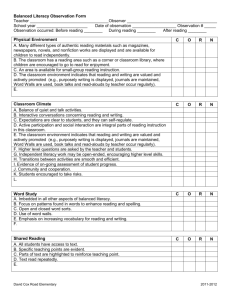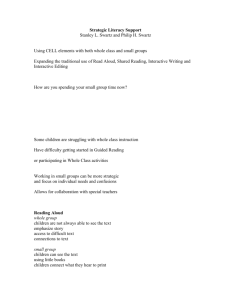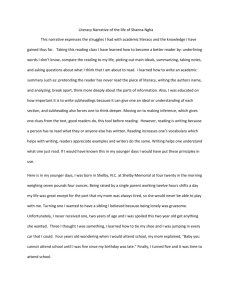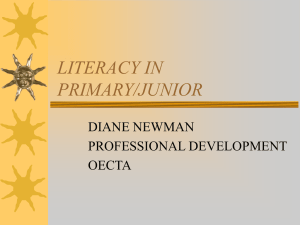What is Balanced Literacy
advertisement
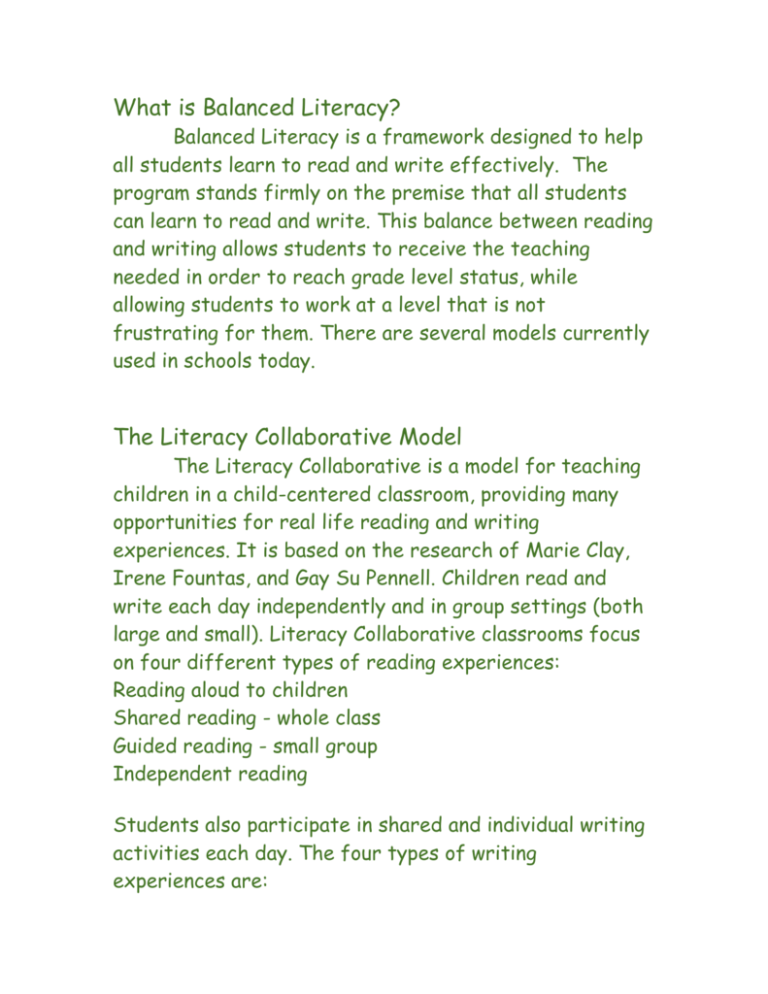
What is Balanced Literacy? Balanced Literacy is a framework designed to help all students learn to read and write effectively. The program stands firmly on the premise that all students can learn to read and write. This balance between reading and writing allows students to receive the teaching needed in order to reach grade level status, while allowing students to work at a level that is not frustrating for them. There are several models currently used in schools today. The Literacy Collaborative Model The Literacy Collaborative is a model for teaching children in a child-centered classroom, providing many opportunities for real life reading and writing experiences. It is based on the research of Marie Clay, Irene Fountas, and Gay Su Pennell. Children read and write each day independently and in group settings (both large and small). Literacy Collaborative classrooms focus on four different types of reading experiences: Reading aloud to children Shared reading - whole class Guided reading - small group Independent reading Students also participate in shared and individual writing activities each day. The four types of writing experiences are: Shared writing - whole class Interactive writing - whole class Writer's workshop - small groups or individual Independent writing Additionally, during many daily reading and writing experiences, children are taught about letters, sounds, words and how they work. Listening and speaking are also emphasized in this integrated language approach. All experiences meet New York State Standards for Language Arts Instruction. Teachers implementing the Literacy Collaborative use an integrated approach to teaching language arts. The Literacy Collaborative framework for literacy lessons consists of a number of elements that provide massive amounts of reading and writing on a daily basis. These authentic opportunities for reading and writing are arranged on a continuum based on more or less teacher support. Some reading and writing tasks are modeled by the teachers and others are accomplished with the support of the teacher, leading to a few that are done independently by the child. The goal of The Literacy Collaborative is to help children become readers and writers who enjoy and value literacy. Children quickly learn that what they say they can write and what they write they can read. The home-school connection is also an important part of The Literacy Collaborative. Kindergarten students receive KEEP BOOKS to read at home with their parents. These KEEP BOOKS help children to build their own home libraries and allow parents to share in their child's literacy experiences. Read Aloud In "Read Aloud" someone reads a story, book of fiction, news article, picture book, essay, poem, or trade book to another person. Usually this is a practice of parents who want to develop the enjoyment of reading in their young children who want to develop the vocabulary knowledge, focused listening skills, or critical thinking skills of children. Since children usually ask questions about the Read Aloud selection, and these questions lead to explanations, making connections and questions by the reader, informal discussion skills are indirectly developed through Read Aloud activities. In Interactive Read Aloud teachers verbally interact with students before, during and after reading to help them understand and make a variety of connections with the read-aloud selection. The selection can be a nonfiction or fiction narrative, a poem or picture book. During an interactive read-aloud the teacher engages in a series of activities, including: pre-viewing the book; asking students to make predictions and connections to prior knowledge; stopping at purposeful moments to emphasize story elements, ask guiding questions or focus questions; and using oral or written responses to bring closure to the selection. Shared Reading Shared Reading is a link in helping students become independent readers. It allows the teacher to model and support students using prediction and confirming skills. It allows less confident students the chance to share stories/articles/poetry in a non-threatening situation. It focuses on the meaning, fun, enjoyment, characters and sequence of a story and allows them to relate it back to their own experiences. It promotes discussion, problemsolving and critical thinking by students. Shared Reading is an interactive reading experience. An integral component of Shared Reading is an enlarged text that all children can see. Children join in the reading of a big book or other enlarged text such as songs, poems, charts, and lists created by the teacher or developed with the class through Shared and Interactive Writing. During the reading the teacher involves the children in reading together by pointing to or sliding below each word in the text. The teacher deliberately draws attention to the print and models early reading behaviors such as moving from left to right and word-by-word matching. Shared reading models the reading process and strategies used by readers. In the shared reading model there are multiple readings of the books over several days. Throughout, children are actively involved in the reading (Yaden, 1988). During the initial reading, the teacher: * Introduces the book (shares theme, examines title, cover, illustrations, and makes predictions) * Relates prior experience to text * Concentrates on enjoying the text as a whole * Encourages students to use background knowledge to make predictions * Encourages spontaneous participation in the reading of the story * Discusses personal responses to the book Texts are usually read multiple times over a period of days or weeks. The first reading emphasizes reading for enjoyment. Subsequent readings aim to increase participation, teach about book characteristics and print conventions, teach reading strategies, help develop a sight vocabulary of high frequency words, and teach phonics. During subsequent readings, the teacher: * Directs children's attention to various aspects of the text, and reading strategies, and skills. * Identifies vocabulary, ideas and facts, * Discusses author's style * Experiments with intonation and expression * Discusses colorful phrases or words. Students participate by: * choral reading * dramatization * masking activities * word work such as "Be the Words" or sorting the words Through repeated readings and the predictable text, children become familiar with word forms and begin to recognize words and phrases (Bridge, Winograd, & Haley, 1983; Pikulski & Kellner, 1992). During Shared Reading... * Rich, authentic, interesting literature can be used, even in the earliest phases of a reading program, with children whose word-identification skills would not otherwise allow them access to this quality literature. * Each reading of a selection provides opportunities for the teacher to model reading for the children. * Opportunities for concept and language expansion exist that would not be possible if instruction relied only on selections that students could read independently. * Awareness of the functions of print, familiarity with language patterns, and word-recognition skills grow as children interact several times with the same selection. * Individual needs of students can be more adequately met. Accelerated readers are challenged by the interesting, natural language of selections. Because of the support offered by the teacher, students who are more slowly acquiring reading skills experience success. Guided Reading Guided reading is an instructional reading strategy during which a teacher works with small groups of children who have similar reading processes and needs. The teacher selects and introduces new books carefully chosen to match the instructional levels of students and supports whole text reading. Readers are carefully prepared when being introduced to a new text and various teaching points are made during and after reading. Guided reading fosters comprehension skills and strategies, develops background knowledge and oral language skills, and provides as much instructional-level reading as possible. During guided reading, students are given exposure to a wide variety of texts and are challenged to select from a growing repertoire of strategies that allow them to tackle new texts more independently. Ongoing observation and assessment help to inform instruction and grouping of students is flexible and may be changed often. Comparison of Traditional and Guided Reading Groups Traditional Reading Groups Guided Reading Groups Groups remain stable in composition. Groups are dynamic, flexible, and change on a regular basis. Students progress through a specific sequence of stories and skills. Stories are chosen at appropriate level for each group; there is no prescribed sequence. Introductions focus on new vocabulary. Introductions focus on meaning with some attention to new and interesting vocabulary. Skills practice follows reading. Skills practice is embedded in shared reading. Focus is on the lesson, not the student. Focus is on the student, not the lesson. Teacher follows prepared "script" from the teacher's guide. Teacher and students actively interact with text. Questions are generally limited to factual recall. Questions develop higher order thinking skills and strategic reading. Teacher is interpreter and checker of meaning. Teacher and students interact with text to construct meaning. Students take turn reading orally. Students read entire text silently or with a partner. Focus is on decoding words. Focus is on understanding meaning. Students respond to story in workbooks or on prepared worksheets. Students respond to story through personal and authentic activities. Readers are dependent on teacher direction and support. Students read independently and confidently. Students are tested on skills and literal recall at the end of each story/unit. Assessment is ongoing and embedded in instruction Independent Reading Independent Reading is a time when students self-select and independently read appropriate books. Independent Reading provides an opportunity to apply strategies that are introduced and taught during teacher read aloud, shared reading, and guided reading. When materials are appropriate and students can read independently, they become confident, motivated and enthusiastic about their ability to read. Children make great contributions to their own learning when they are given some control and ownership of the reading process. The self-selection process of Independent Reading places the responsibility for choosing books in the hands of the student. This teaches them that they have the ability to choose their own reading materials and that reading by themselves is a valuable and important activity. While students are free to choose what they like, they must be encouraged to select a variety of literature and to select materials at their independent reading level. Independent means 95% to 100% accuracy as defined by running records. These materials should be able to be read without teacher support. It is at the independent level that comprehension, vocabulary extension, and fluency are improved. Shared Writing Shared Writing or Modeled Writing is an approach to writing where the teacher and children work together to compose messages and stories. Children provide the ideas and the teacher supports the process as a scribe. The message is usually related to some individual or group experience. The teacher provides full support, modeling and demonstrating the process of putting children's ideas into written language. The text becomes much richer than children can write themselves and becomes good material for children to read and should be displayed in the room. The children can illustrate the finished text when possible. Children will love to see their work displayed and will feel successful because they can read it. Interactive Writing During interactive writing the teacher and class, or small group, work together to create written text. The group agrees on what to write through discussion and negotiation. In order to produce the written words, the students articulate the sounds with the teacher and then write the letters and chunks of words that they hear. The teacher may fill in parts of words or whole words, depending upon the group's stage of writing development. Interactive writing is used for creating stories, writing poems, the retelling of favorite literature, recipes, directions and lists. The pieces created by the students become a part of the classroom environment and are used for reading and rereading.The class may use the pieces for shared reading or may enjoy reading some independently. Writer's Workshop The basic philosophy behind writing workshop is to allow students to daily spend time writing for real purposes about things that interest them. Students can experiment with a variety of genres. English, spelling, handwriting and other mechanics can be taught within writing workshop. Students learn the craft of writing through practice, conferring, and studying the craft of other authors. The ultimate goal of a writing workshop is always to develop life-long writers. Within the context of Writer’s Workshop, a variety of organizational patterns for instruction are used: a whole class session, a small group mini-lesson, a student-teacher conference, and a sharing of written work. The Writer’s Workshop is devoted to supporting student learning in writing. What students need to learn during a Writer’s Workshop is based upon their present writing competencies and the English language arts standards and benchmarks for each grade level. For the majority of the time in Writer’s Workshop, students will be engaged in actual writing. Writer's Workshop gives children daily opportunities to develop their unique writing processes and communicate meaning through words and pictures. Independent Writing During independent writing in kindergarten, children are encouraged to get ideas on paper by using pictures, letters, and words. Children can write in journals, make their own books, or write notes. Teachers should accept approximations so that children will have opportunities to become risk takers and explore sound to letter relationships. Working with Words The field of "word study" provides students an opportunity to manipulate words (and parts of words) in meaningful and enjoyable activities and games. Reading ability can develop dramatically as word study lessons develop experience with: - Letters and their corresponding sounds. - Components of words, such as roots, prefixes, and suffixes. - Patterns of how words are spelled, such as word families. - How parts of words often will give hints to the meaning of a word, as well as its spelling or pronunciation. Word study activities call for active problem solving. Students are encouraged to look for spelling patterns, form hypotheses, predict outcomes, and test them. These activities require students to continually ask themselves, "What do I know about this new word, and how is it similar to words that I already know?"
